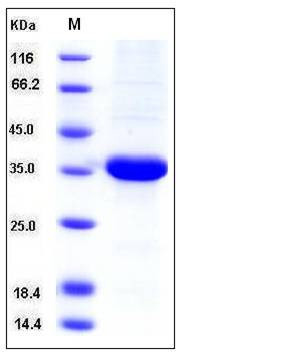Human ACBD6 Protein (His Tag)
MGC2404, ACBD6
- 100ug (NPP3552) Please inquiry
| Catalog Number | P11112-H07B |
|---|---|
| Organism Species | Human |
| Host | Baculovirus-Insect Cells |
| Synonyms | MGC2404, ACBD6 |
| Molecular Weight | The recombinant human ACBD6 consists of 300 amino acids and predicts a molecular mass of 33.4 kDa. It migrates as an approximately 36 kDa band in SDS-PAGE under reducing conditions. |
| predicted N | His |
| SDS-PAGE |  |
| Purity | > 96 % as determined by SDS-PAGE |
| Protein Construction | A DNA sequence encoding the full length of human ACBD6 (NP_115736.1) (Met 1-Ala 282) was expressed, with a polyhistidine tag at the N-terminus. |
| Bio-activity | |
| Research Area | Signaling |Signal Transduction |Metabolism |Pathways and Processes |Metabolic signaling pathways |Lipid and lipoprotein metabolism | |
| Formulation | Lyophilized from sterile 50mM Tris, 100mM NaCl, pH 8.0 1. Normally 5 % - 8 % trehalose, mannitol and 0.01% Tween80 are added as protectants before lyophilization. Specific concentrations are included in the hardcopy of COA. |
| Background | Human acyl-coenzyme A binding domain-containing member 6 (ACBD6) is a modular protein that carries an acyl-CoA binding domain at its N terminus and two ankyrin motifs at its C terminus. In mammals, there are six members of the acyl-CoA binding domain-containing (ACBD) family, and their annotation is not uniform. All six ACBD proteins contain an ACB domain at the N terminus, but they do not share significant homology at the C-terminal region. ACBD6 is a 32 kDa protein that is predicted by sequence analysis to carry an ACB domain between residues 42 and 125 and two ANK motifs at its C terminus. This protein binds long-chain acyl-CoAs with a strong preference for unsaturated, C18:1-CoA and C20:4-CoA, over saturated, C16:0-CoA, acyl species. ACBD6 is not a ubiquitous protein, but it is expressed in hematopoietic tissues and appears to be restricted to primitive stem cells present in those tissues with functions in blood and vessel development. ACBD6 was detected in bone marrow, spleen, placenta, cord blood, circulating CD34+ progenitors, and embryonic-like stem cells derived from placenta. In placenta, the protein was only detected in CD34+ progenitor cells present in blood and in CD31+ endothelial cells surrounding the blood vessels. These cells were also positive for the marker CD133, and they probably constitute hemangiogenic stem cells, precursors of both blood and vessels. We propose that human ACBD6 represents a cellular marker for primitive progenitor cells with functions in hematopoiesis and vascular endothelium development. |
| Reference |
